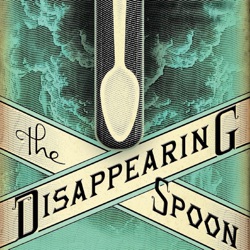Avsnitt
-
A young woman in the mid-1900s couldn’t take an at-home pregnancy test. Instead, she sent a vial of urine to a clinic, where a technician would, of all things, inject it into a frog, and hormones in the urine would cause the frog to lay eggs. This frog-based test was far faster, easier, and cleaner than any pregnancy test before, and it shifted power for family planning from doctors to women themselves.
preorder hardcover copies of MY NEW BOOK, Dinner with King Tut, for a 20 percent discount at this link only: bit.ly/dinnerwithkingtut. Use offer code “spoon”. This offer will EXPIRE SOON, so take advantage today! -
After scientists had a handle on how many chromosomes humans have, other researchers began exploring whether certain ailments might be caused by chromosomal abnormalities. To this end, a French cardiologist discovered that Down syndrome was caused by the presence of an extra chromosome in humans. But a colleague stole credit for her work, and the battle over their legacies continues to this day, in part because the colleague is on track to become a certified Catholic saint.
preorder hardcover copies of MY NEW BOOK, Dinner with King Tut, for a 20 percent discount at this link only: bit.ly/dinnerwithkingtut. Use offer code “spoon”. -
Saknas det avsnitt?
-
It seems like a simple question: how many chromosomes do human beings have? But getting an accurate count proved surprisingly hard for much of last century. In fact, virtually every textbook once cited an incorrect number, until in 1956, a fiery Indonesian scientist finally determined the true count—and had to battle his boss over who would receive credit for this legacy-making discovery.
preorder hardcover copies of MY NEW BOOK, Dinner with King Tut, for a 20 percent discount at this link only: bit.ly/dinnerwithkingtut. Use offer code “spoon”. -
The 1910 return of Halley’s comet was greeted with rapture around the world—at least at first. Due to irresponsible speculation by scientists about the theoretical dangers of a close encounter with a comet, many people grew terrified of Halley’s approach and took drastic measures. They fled their homes, hid out in wells or caves, even committed suicide. It’s a grave reminder of scientific communication gone very wrong.
preorder hardcover copies of MY NEW BOOK, Dinner with King Tut, for a 20 percent discount at this link only: bit.ly/dinnerwithkingtut. Use offer code “spoon”. This offer will EXPIRE SOON, so take advantage today! -
It’s the 80th anniversary of the Dutch Hongerwinter during World War II, which led to widespread starvation, and an inadvertent breakthrough in treating deadly celiac disease.
-
Parasites can force animals to do nefarious things by manipulating their minds—including, uncomfortably, the minds of human beings.
-
Japanese physicist Fusa Miyake has sparked a revolution in archaeology by studying radioactive tree rings—work that also terrifies astronomers, who fear it foretells doom for our civilization.
-
A woman who drowned in Paris became one of the most famous faces in the world as the model for CPR dummies, saving millions of lives and inspiring artists from Pablo Picasso to Michael Jackson—all while remaining completely unknown.
-
In the early 1800s, the first Egyptian mummies in Europe served as a crucial test for evolution—a test that, according to people then, evolution flunked.
-
In the 1800s, mummies found their way into everything from fertilizer to food, and were especially prized as medicine. Mummymania was a strange time...
-
Physicist Gyorgy Hevesy had a talent for tricks and stunts—including one that prevented Nazi stormtroopers from stealing a gold Nobel Prize.
-
A summer bonus episode: Russ Schnell's professors mocked him for believing that plants somehow caused hailstorms. He not only proved them wrong, but uncovered profound connections between life, earth, and the air above...
-
Ahead of the 80th anniversary of the D-Day landings, a look at the surprisingly important role science played in shaping—and remaking—an invasion that could have easily been a disaster...
-
In 1959, nine Russian hikers mysteriously died on a trek through the snowy wilderness—fueling a half-century of hysterical conspiracies. Has science finally cracked the case?
-
After a tenure dispute, mechanical engineer Valery Fabrikant murdered four colleagues in cold blood at his university in Montreal. So why is he still allowed to publish scientific papers?
-
Chemist Justus von Liebig was perhaps the most famous scientist in the world in the mid-1800s—but quickly became infamous for his role in the killing of four starving infants.
- Visa fler


